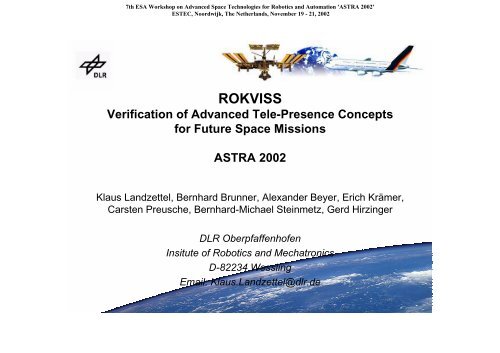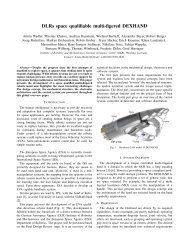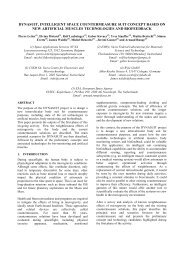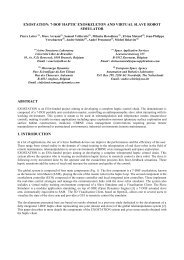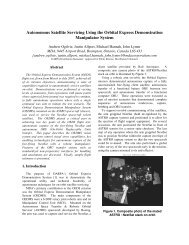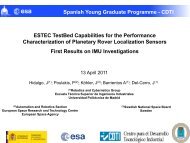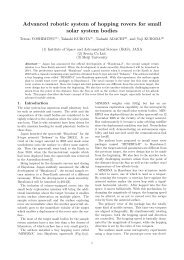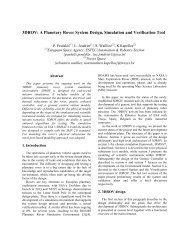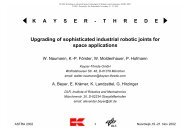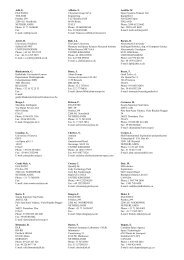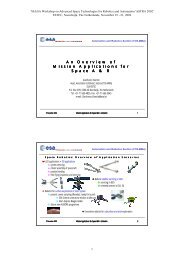ROKVISS - Automation & Robotics - Esa
ROKVISS - Automation & Robotics - Esa
ROKVISS - Automation & Robotics - Esa
You also want an ePaper? Increase the reach of your titles
YUMPU automatically turns print PDFs into web optimized ePapers that Google loves.
<strong>ROKVISS</strong><br />
Verification of Advanced Tele-Presence Concepts<br />
for Future Space Missions<br />
ASTRA 2002<br />
Klaus Landzettel, Bernhard Brunner, Alexander Beyer, Erich Krämer,<br />
Carsten Preusche, Bernhard-Michael Steinmetz, Gerd Hirzinger<br />
DLR Oberpfaffenhofen<br />
Insitute of <strong>Robotics</strong> and Mechatronics<br />
D-82234 Wessling<br />
Email: Klaus.Landzettel@dlr.de
"The goal of <strong>ROKVISS</strong> is to test and verify the long-term<br />
reliability of a new generation of lightweight robotics<br />
components in free space operation.<br />
"The intelligent robotic joints were developed at DLR‘s<br />
Institute of <strong>Robotics</strong> and Mechatronics in<br />
Oberpfaffenhofen.<br />
"The new light weight robot is able to handle loads equal<br />
to its own mass, while conventional robots only achieve<br />
a ratio of roughly 1:10 to 1:15.
DLR‘s new generation of light weight robots
Kinematics Example
Control architecture<br />
4-th order joint state feedback: qm, dqm, τ, dτ Joint level<br />
Position k➔maxImpedance<br />
k➔0 Torque<br />
control control<br />
3kHz<br />
control<br />
stiff robot<br />
dynamics<br />
inverse<br />
kinematics<br />
serial bus<br />
1kHz<br />
Impedance<br />
control<br />
adaptive gain<br />
adjustment<br />
Force<br />
control<br />
motor position<br />
joint torque<br />
link position<br />
cartesian<br />
level<br />
Force-torque<br />
sensor
Modifications Towards Free Space Application<br />
"Joint arrangement modified from an<br />
inline arrangement to an offset<br />
arrangement.<br />
"For <strong>ROKVISS</strong> PCBs are mounted into<br />
separate circular aluminum housings<br />
and shedded afterwards.<br />
"Input current observing to prevent destruction due to single<br />
event latch-ups.
<strong>ROKVISS</strong> Components<br />
"<strong>ROKVISS</strong> will be installed at the Russian Service<br />
Module (SM).<br />
"It consists of a small 2-joints robot, mounted on a<br />
Universal Workplate (UWP), a controller, a stereo<br />
camera, an illumination system, a power supply, and a<br />
mechanical contour device to verify the robot's functions<br />
and performance.
<strong>ROKVISS</strong> Robotic System<br />
Joint 1<br />
Joint 2<br />
Stylus<br />
Stereo camera & illumination<br />
Experiment contour
Operational Modes<br />
"<strong>ROKVISS</strong> will be operated in the tele-presence mode<br />
while the ISS is in direct (S-band) radio contact with the<br />
German tracking station in Weilheim.<br />
"Robot tasks are executed in autonomous mode to verify<br />
and identify joint parameters during non contact phases.<br />
The joint parameters are stored on-board and downlinked<br />
on demand during the next possible radio contact<br />
phase.<br />
"All experiments will be repeated several times during the<br />
entire mission to yield comparable sets of data.
Tele-Presence Mode for <strong>ROKVISS</strong><br />
" For the most space robotics applications in the field of servicing and<br />
maintenance, the direct inclusion of an human operator into the<br />
control loop is inevitable, because such missions couldn’t be<br />
prepared in detail off-line on-ground.<br />
" It opens up a much broader range of applications for telerobotic<br />
systems, because the operator can apply his skills on the remote<br />
site, almost as if he would be currently present there.<br />
" <strong>ROKVISS</strong> provides a good means to evaluate and demonstrate the<br />
capability of the tele-presence mode in a realistic space mission<br />
scenario.
Tele-Presence Mode for <strong>ROKVISS</strong><br />
"Tele-presence demands a low signal round trip time,<br />
high sampling frequency and a neglectable jitter.<br />
– Round trip < 500 ms<br />
• Ground LEO ~ 2 ms<br />
• Ground GEO ~ 240 ms<br />
• Ground LEO via relay in GEO ~ 480 ms<br />
– Sampling rate 2 ms min<br />
– Jitter < 50% of sampling rate
<strong>ROKVISS</strong> Experiments<br />
" Tele-Presence Mode Experiments<br />
" Peg-in-hole<br />
" Contour-following<br />
" Virtual-spring<br />
" Real-spring<br />
" Experiments with simulated increased round trip time<br />
" Automatic Mode Experiments<br />
" Experiments for the identification of the joint dynamics<br />
parameters for controller design<br />
" Experiments for impedance control<br />
" Contact Dynamics Experiment (CSA)<br />
" Public Outreach Experiments<br />
" It is planned to take photos of the ISS, incoming and outgoing<br />
spacecraft, and the extravehicular activities of the astronauts.


